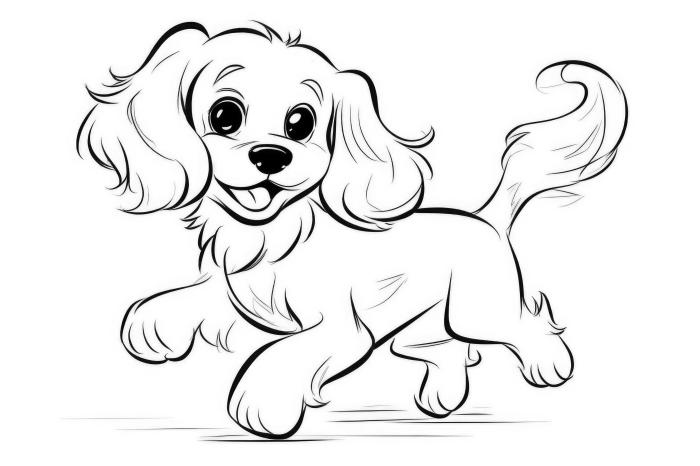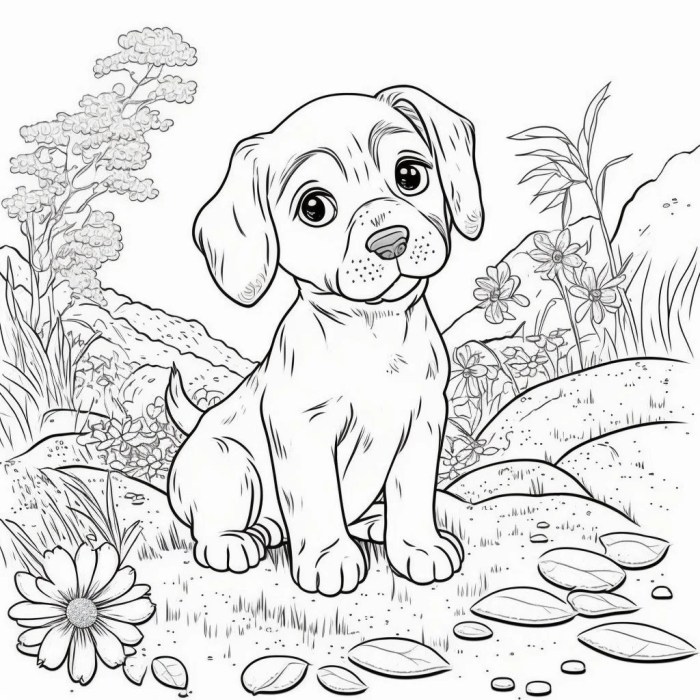Market Research & Trends
The market for adult coloring books has experienced significant growth in recent years, and dog-themed coloring pages represent a substantial and popular niche within this broader trend. This popularity stems from the therapeutic benefits associated with coloring, combined with the widespread love of dogs. Understanding the market trends and demographics is crucial for successfully marketing and selling dog coloring book pages.
Current Popularity of Dog Coloring Book Pages
Dog coloring book pages enjoy considerable popularity, driven by several factors. The relaxing and meditative aspects of coloring appeal to a broad audience seeking stress relief and creative outlets. Furthermore, the inherent appeal of dogs – their playful nature, loyalty, and diverse breeds – makes them a consistently popular subject matter for creative expression. The rise of online platforms like Etsy and Amazon has also significantly broadened the reach and accessibility of these products, contributing to their increased popularity.
The ongoing trend towards mindful activities and self-care further fuels the demand for such products.
Key Demographics Interested in Dog Coloring Book Pages
The primary demographic interested in dog coloring book pages includes adults aged 25-55, with a higher concentration within the 35-45 age range. This group often includes individuals seeking stress relief, creative hobbies, or those with a strong affinity for dogs, either as pet owners or dog lovers. However, the market also extends to younger adults and older adults, particularly those interested in therapeutic activities or engaging in creative pursuits.
There’s also a notable segment of pet owners who find it personally fulfilling to color images of their own breeds or similar canine companions.
Market Share of Different Types of Dog Coloring Book Pages
The market for dog coloring book pages encompasses a variety of styles. Realistic depictions of dog breeds tend to appeal to a more mature audience interested in anatomical accuracy and detailed rendering. Cartoonish or whimsical styles are popular with younger adults and children, offering a simpler and more playful approach. Breed-specific coloring books cater to niche markets, focusing on individual breeds and their distinctive features.
Dog coloring book pages offer a relaxing creative outlet, perfect for unwinding after a long day. For a slightly different, humorous take on everyday life, you might also enjoy the quirky illustrations found in the people of walmart coloring book ; it’s a fun contrast to the often-adorable canine subjects. Returning to our furry friends, the detailed line art in many dog coloring books allows for intricate shading and personalization, making each page unique.
Precise market share data is difficult to obtain publicly, but anecdotal evidence suggests that realistic and breed-specific books command a higher price point, potentially indicating a larger profit margin despite possibly lower sales volume compared to more widely appealing cartoonish designs.
Current Pricing Strategies for Similar Products, Dog coloring book pages
Pricing strategies for dog coloring book pages vary depending on factors such as the number of pages, paper quality, binding type (spiral, saddle-stitch, etc.), and the artistic style. Simple, digitally printed coloring books with fewer pages might retail for $5-$10, while higher-quality books with thicker paper, intricate designs, and a more elaborate binding can command prices ranging from $15-$30 or more.
Print-on-demand services allow for flexible pricing and minimize upfront costs, while larger-scale printing operations typically offer lower per-unit costs for higher volume orders. Premium paper stock, unique binding methods, and added features such as stickers or bonus content can justify higher price points. Many creators leverage digital marketplaces, allowing for competitive pricing based on market analysis and customer demand.
Design & Illustration Styles

Creating visually appealing and engaging coloring pages requires careful consideration of design and illustration styles. The choice of style significantly impacts the overall aesthetic and the target audience’s engagement. This section details various approaches to designing dog coloring pages, focusing on layout, illustration techniques, and color palettes.
Three Unique Coloring Page Layouts
Three distinct layouts are proposed, each showcasing a different dog breed and employing varying levels of line complexity. The first features a German Shepherd in a dynamic pose, utilizing thick, bold lines for a simpler coloring experience. This design prioritizes large, easily-colored areas. The second depicts a playful Beagle puppy amidst flowers, employing medium line weight with some intricate details in the floral elements, offering a moderate level of complexity.
The third showcases a regal Great Dane, using thin, delicate lines to create a more detailed and intricate design, appealing to more experienced colorists. Line weight directly correlates with coloring difficulty and target age group.
Playful Puppy Coloring Page Design
This page centers on a Golden Retriever puppy, playfully chasing its tail in a sun-drenched meadow. The line art is predominantly medium weight, with thinner lines used for details like fur texture and grass blades. The color palette is bright and cheerful, featuring warm yellows and golds for the puppy’s coat, contrasting with vibrant greens and blues for the meadow.
Additional design elements include butterflies fluttering around the puppy and sunbeams radiating from the sky. These elements add visual interest and provide further coloring opportunities. The overall style is slightly stylized, avoiding hyper-realism for a more approachable and fun coloring experience.
Realistic vs. Stylized Dog Illustrations
Realistic illustrations strive for accurate anatomical representation and detailed rendering of fur, texture, and features. They are often more complex to color, appealing to older children and adults seeking a challenging artistic endeavor. Examples include highly detailed illustrations of show dogs, capturing the precise nuances of their breed standards. Stylized illustrations prioritize artistic expression over strict realism. They may simplify anatomical features, exaggerate proportions, or incorporate playful design elements.
These are generally easier to color, making them suitable for younger children. Examples include cartoonish depictions of dogs or illustrations employing a minimalist or graphic style.
Line Art Techniques for Dog Coloring Pages
Several line art techniques are suitable for dog coloring pages. Ink drawing offers crisp, clean lines, suitable for both realistic and stylized illustrations. Digital line art, created using graphic design software, allows for precise control over line weight and detail. Pencil sketching, followed by digital inking or clean-up, offers a more organic feel. Each technique contributes a unique aesthetic.
Ink drawing provides a classic, timeless look; digital line art allows for intricate details and precise lines; while pencil sketching offers a softer, less defined aesthetic. The choice of technique should align with the desired style and level of complexity.
Content & Features: Dog Coloring Book Pages

This section details the specific content and features planned for the dog coloring book, focusing on breed selection, thematic organization, design elements, and suggested color palettes to enhance the overall user experience and appeal. A careful selection of breeds, themes, and design elements will ensure the coloring book is both engaging and visually appealing to a broad audience.
Dog Breeds for Coloring Pages
The following ten dog breeds offer a diverse range of visual characteristics suitable for coloring book pages, catering to different levels of detail and artistic expression. Each breed possesses unique features that translate well into a coloring book format.
- Golden Retriever: Known for their friendly faces and golden coats, Golden Retrievers are a popular choice for their approachable appearance.
- German Shepherd: Their striking markings and alert expressions provide opportunities for detailed coloring.
- Poodle: The fluffy coats of Poodles, in various sizes and cuts, offer interesting textural challenges for coloring.
- Labrador Retriever: Similar to Golden Retrievers, Labradors provide a familiar and appealing subject with their expressive eyes.
- Dachshund: Their long bodies and short legs offer a unique and charming silhouette.
- French Bulldog: Their bat-like ears and wrinkled faces provide interesting details for coloring.
- Beagle: Beagles’ expressive eyes and floppy ears make them endearing subjects for coloring.
- Pug: Their charmingly wrinkled faces and curled tails are visually appealing and fun to color.
- Shiba Inu: Their distinctive fox-like features and striking coat colors offer a more challenging and rewarding coloring experience.
- Yorkshire Terrier: Their long, flowing coats provide opportunities for intricate detailing and shading.
Themes for Dog Coloring Pages
These five themes provide a framework for organizing the coloring pages, offering varied scenarios and visual interest. The themes are designed to be engaging and relatable for a wide range of users.
- Puppies Playing: Depicting energetic puppies in playful scenarios.
- Dogs at the Beach: Showcasing dogs enjoying the seaside, with sand, waves, and beach toys.
- Herding Dogs at Work: Illustrating herding breeds like Border Collies or Australian Shepherds working with livestock.
- Dogs in Festive Attire: Featuring dogs dressed up for holidays or special occasions.
- Dogs Relaxing at Home: Showcasing dogs in comfortable, cozy settings, perhaps sleeping or playing with toys.
Creative Design Elements
Incorporating these design elements will enhance the visual appeal and engagement of the coloring pages. These elements add layers of complexity and fun to the coloring experience.
- Paw Prints: Scattered paw prints add a playful touch and create a sense of movement.
- Dog Toys: Including various dog toys like tennis balls, squeaky toys, and ropes adds visual interest.
- Bones: Chew bones scattered around the dogs add a thematic element and visual appeal.
- Dog Collars and Leashes: Adding these accessories provides additional detail and realism.
- Simple Backgrounds with Geometric Patterns: These provide a visually interesting backdrop without overwhelming the main subject.
Breed, Age, Activity, and Color Palette Suggestions
This table provides suggestions for color palettes based on breed, age, and activity level. These suggestions are intended as starting points, and artists are encouraged to experiment and personalize their choices.
| Breed | Age | Activity | Color Palette Suggestion |
|---|---|---|---|
| Golden Retriever | Puppy | Playing | Warm yellows, oranges, browns, and creams |
| German Shepherd | Adult | Working | Blacks, browns, tans, and grays |
| Poodle | Senior | Relaxing | Soft whites, creams, and pastels |
| French Bulldog | Adult | Sleeping | Creams, browns, and fawn shades |
